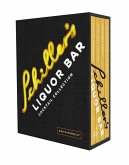"How to Mix Drinks" by Jerry Thomas, also known as "The Bon Vivant's Companion," is a classic and pioneering cocktail book that holds a special place in the history of mixology. Jerry Thomas, a legendary bartender of the 19th century, is often considered the father of American bartending, and this book, first published in 1862, is one of the earliest and most influential cocktail guides. Key Features: Historical Significance: "How to Mix Drinks" is a historic treasure, representing a crucial moment in the evolution of cocktail culture. Jerry Thomas played a pivotal role in popularizing and codifying the art of mixing drinks during the Golden Age of Cocktails. Pioneer of Mixology: Jerry Thomas is credited with being one of the first bartenders to showcase flair and showmanship in mixing drinks. His book is not just a collection of recipes but a demonstration of the theatrical aspects of bartending that have influenced the profession to this day. Classic Cocktails: The book features an array of classic cocktails that have stood the test of time. Many of these cocktails, including the Tom Collins and the Blue Blazer, are still enjoyed today and have become staples in bars around the world. Cocktail Techniques: Thomas provides insights into essential cocktail techniques, including the proper way to shake, stir, and garnish drinks. His instructions are practical and have laid the foundation for modern bartending practices. Elegance and Style: The book reflects the elegance and style of the Victorian era, with elaborate illustrations and a tone that captures the sophistication of the time. The language used in the recipes and anecdotes adds a touch of charm and nostalgia. Anecdotes and Stories: Interspersed with the cocktail recipes are anecdotes, stories, and entertaining narratives that provide a glimpse into the social and cultural context of the 19th-century bar scene. These stories contribute to the overall charm of the book. Innovative Presentation: Jerry Thomas was known for his innovative and theatrical presentation of cocktails, and this is evident in the book. The Blue Blazer, a flaming whiskey cocktail, is a notable example that showcases his showmanship. Legacy and Influence: "How to Mix Drinks" has had a lasting impact on the world of cocktails. Jerry Thomas's legacy as a pioneer in mixology endures, and his book continues to inspire both professional bartenders and home enthusiasts. For anyone passionate about mixology, cocktail history, or the art of bartending, "How to Mix Drinks" is a captivating journey into the roots of modern cocktail culture. It not only provides a collection of timeless recipes but also offers a glimpse into the charisma and skill of one of the industry's founding figures, Jerry Thomas.








